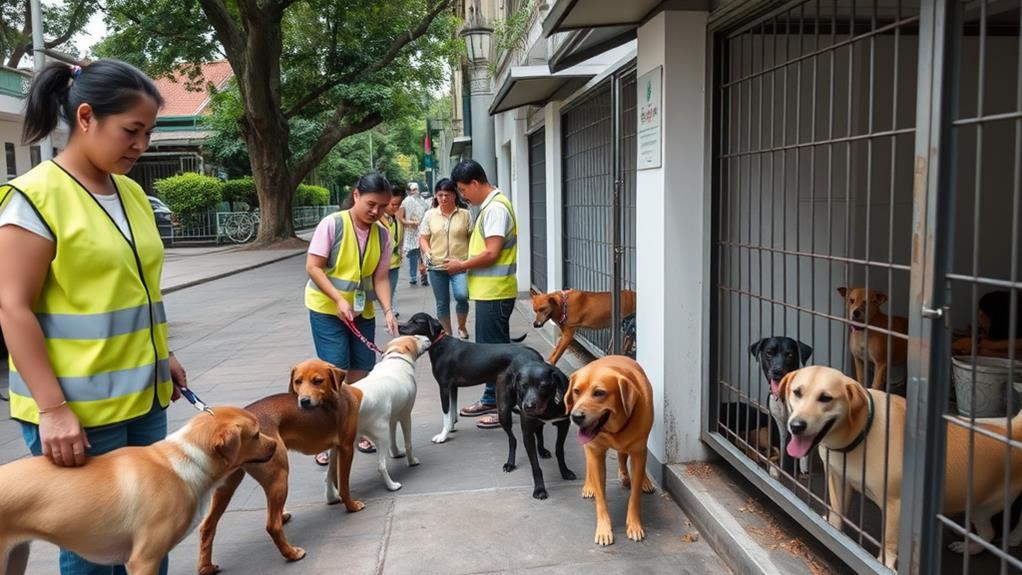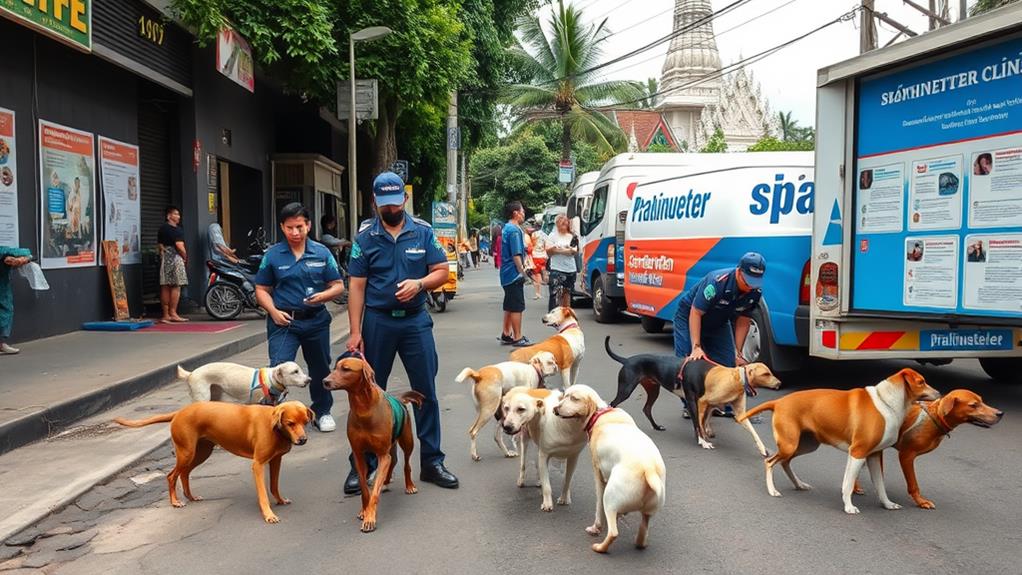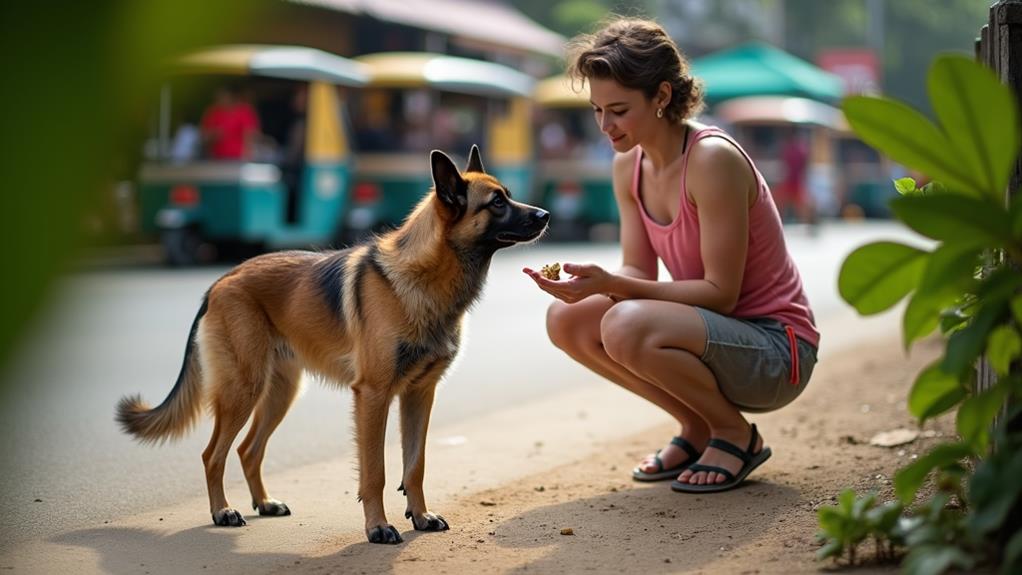When encountering stray dogs in Thailand, stay calm and avoid aggressive approaches. Recognize warning signs like stiff body posture and growling. Use deterrents such as pepper spray or a firm voice if needed. Don't make direct eye contact and back away slowly from tense situations. Support local animal welfare organizations to address the root causes of the stray dog issue. Be mindful of cultural considerations, like the Buddhist tradition of feeding strays, but practice responsible feeding ethics. Understanding the nuances of Thailand's stray dog situation will help you navigate encounters safely and contribute positively to long-term solutions.
Table of Contents
Key Takeaways
- Remain calm and avoid aggressive approaches when encountering stray dogs in Thailand.
- Recognize signs of aggression like stiff body posture and employ de-escalation techniques.
- Use deterrents such as pepper spray, whistles, or air horns if necessary.
- Support local animal welfare organizations through donations or volunteering.
- Practice responsible feeding ethics if choosing to feed strays, avoiding overfeeding.
Understanding Thailand's Stray Dog Situation
Confronted with an overwhelming stray dog population, Thailand faces a complex and deeply rooted issue. With an estimated 8.5 million stray dogs nationwide, including 640,000 in Bangkok alone, the scale of the problem is significant. You'll encounter these street dogs frequently, especially in urban areas.
Several factors contribute to this situation. Thai culture encourages feeding stray animals, inadvertently supporting their reproduction and population growth. Limited access to affordable spay/neuter services exacerbates the problem, resulting in countless puppies born on the streets each year. These conditions create a cycle that's challenging to break.
The challenges faced by stray dogs are numerous. In bustling cities like Bangkok, road accidents pose a significant threat to their safety. While many shelters across Thailand house hundreds or even thousands of dogs, overall improvements in Animal Care remain restricted.
Understanding this context is pivotal when dealing with stray dogs in Thailand. You'll need to balance compassion with practicality, recognizing that the issue stems from deeply ingrained cultural practices and systemic limitations. By grasping the full scope of the situation, you can better navigate encounters with stray dogs and contribute positively to addressing this widespread concern.
Safety Precautions When Encountering Strays
When you encounter stray dogs in Thailand, it's important to remain calm and avoid aggressive approaches that may provoke them.
Don't make sudden movements or loud noises, as these can startle the dogs and trigger defensive behaviors.
If you feel threatened, use deterrents wisely, such as carrying a stick or umbrella to create a visual barrier, but never strike the animals unless absolutely necessary for self-defense.
Avoid Aggressive Approaches
While encountering stray dogs in Thailand, it's essential to avoid aggressive approaches that might trigger defensive or hostile reactions. Stray dogs can exhibit aggressive behavior when they feel threatened or cornered, so it's critical to maintain a calm and non-threatening demeanor.
If you come across aggressive dogs, resist the urge to confront them directly. Instead, remain calm and avoid making sudden movements or loud noises that could startle them. Don't attempt to pet or feed the dogs, as this could be misinterpreted as a threat. Keep a safe distance and refrain from making direct eye contact, which dogs may perceive as a challenge.
If a stray dog appears agitated or starts barking, slowly walk away without turning your back on the animal. Your goal is to remove yourself from the situation without escalating it.
Use Deterrents Wisely
Although avoiding aggressive approaches is essential, it's wise to be prepared with effective repellents when encountering stray dogs in Thailand. Carrying repellents like pepper spray or rocks can provide an added layer of protection and boost your confidence when walking in areas known for stray dogs.
Pepper spray is particularly efficient in deterring aggressive stray dogs without causing them long-term harm. It's important to remember that these repellents should only be used as a last resort in self-defense situations. When you're carrying repellents, make sure you know how to handle and use them properly to maximize their effectiveness.
While repellents can be helpful, it's important to use them wisely and responsibly. Don't display them unnecessarily, as this may escalate the situation. Instead, keep them readily accessible but out of sight.
If you find yourself in a confrontation with a stray dog, calmly and firmly use your repellent to create distance between you and the animal. By being prepared and using repellents judiciously, you'll be better equipped to handle potential encounters with stray dogs in Thailand safely.
Recognizing Aggressive Dog Behavior

When encountering stray dogs in Thailand, you'll need to quickly recognize warning signs of aggression. Look for stiff body posture, direct eye contact, raised fur, and low growls that indicate potential threats. If you spot these signs, employ de-escalation techniques such as avoiding eye contact, speaking calmly, and slowly backing away to prevent provoking the dog further.
Warning Signs
As you encounter stray dogs in Thailand, it's vital to recognize the warning signs of aggressive behavior. Stray dogs may exhibit various signs of aggression that you should be mindful of to safeguard your safety.
Watch for physical cues that indicate a dog feels threatened or territorial. These include growling, baring teeth, raised hackles, and intense staring. A stiff body posture, raised tail, or ears pinned back are also telltale signs of potential aggression. You might notice the dog lunging or nipping, which are defensive or offensive behaviors.
Understanding these warning signs can help you respond appropriately and avoid escalating the situation. Remember that aggressive behavior in stray dogs often stems from fear or feeling threatened by your presence. They may be protecting their territory or reacting to perceived danger.
De-Escalation Techniques
Recognizing aggressive dog behavior is vital when encountering strays in Thailand. Look for signs like growling, bared teeth, or a stiff body posture. These indicators suggest the dog may be feeling threatened or defensive.
When you spot these warning signs, it's pivotal to employ effective de-escalation techniques. First, avoid direct eye contact with the dog, as this can be perceived as a challenge. Similarly, refrain from making sudden movements or loud noises that might startle or provoke the animal. Instead, maintain a calm demeanor and keep a safe distance.
If you find yourself face-to-face with an aggressive stray dog, slowly back away without turning your back. This approach allows you to maintain control of the situation while gradually removing yourself from the dog's perceived territory. Remember, your goal is to de-escalate the tension and avoid confrontation.
In cases where you encounter a consistently aggressive stray dog, it's advisable to seek help from local authorities or animal control. These professionals are equipped to handle such situations safely and effectively. By understanding and implementing these de-escalation techniques, you'll be better prepared to navigate encounters with stray dogs in Thailand.
Effective Deterrents and Self-Defense Techniques
Encountering stray dogs in Thailand can be intimidating, but there are effective deterrents and self-defense techniques you can use to protect yourself. When faced with aggressive street dogs, pepper spray and rocks are common self-defense tools that can help keep them at bay. Carrying a whistle or air horn is also recommended, as these devices can startle dogs and alert others to your situation.
Your voice can be a vital deterrent. Use a firm, authoritative tone to discourage dogs from approaching. If you find yourself in a tense situation, avoid making eye contact with the dog and slowly back away to de-escalate the encounter.
It's essential to understand canine body language; raised hackles or growling are signs of potential aggression, indicating you should exercise caution.
Supporting Local Animal Welfare Organizations

While dealing with stray dogs is vital, supporting local animal welfare organizations can make a lasting difference in Thailand's street dog population. By contributing to these groups, you're not just helping individual animals but addressing the root causes of the stray dog issue.
Consider donating to organizations like Phangan Animal Care, which provides essential medical care and support for street dogs. Your contributions can fund vaccinations, treatments, and spaying/neutering programs that help control the stray population.
If you have time to spare, volunteering with groups such as FOUR PAWS or Lanta Animal Welfare can directly impact the lives of these animals.
Many local animal welfare organizations also focus on education initiatives. These programs promote responsible pet ownership and the importance of spaying/neutering, which are vital for long-term stray dog population control. By supporting these efforts, you're helping to create a more informed and compassionate community.
Remember that collaboration with local communities is key to the success of these programs. By engaging with and supporting local animal welfare organizations, you're contributing to a sustainable solution for Thailand's stray dog challenges.
Cultural Considerations and Feeding Ethics
Compassion lies at the heart of Thailand's complex relationship with stray dogs. Rooted in Buddhist culture, the practice of feeding stray dogs is deeply ingrained in Thai society. Many locals believe that this act of kindness aligns with the concept of "making merit" and can bring blessings. However, it's fundamental to understand the nuanced implications of this well-intentioned practice.
While feeding stray dogs may seem like a compassionate act, it's important to take into account the long-term consequences. Overfeeding can lead to health issues, dependency, and population growth among street dogs. To address this, you should be mindful of responsible feeding ethics.
This includes providing appropriate portions, avoiding human food that may be harmful to dogs, and not creating feeding spots that could lead to overcrowding.
Government Initiatives and Ongoing Challenges

The Thai government recognizes the magnitude of the stray dog issue, with an estimated 8.5 million strays nationwide and 640,000 in Bangkok alone. To address this challenge, they've initiated sterilization campaigns and partnered with organizations to provide healthcare for these animals. These efforts aim to control the population and improve the overall health of stray dogs.
The government has also implemented laws to prevent animal cruelty and neglect, demonstrating a commitment to animal welfare. However, ongoing challenges persist, particularly concerning public health risks. Stray dogs can carry diseases like rabies and leptospirosis, making rabies vaccination essential for travelers.
Education for the public plays a pivotal role in managing the stray dog population. The government's initiatives include raising awareness among Thai people about responsible pet ownership and the importance of sterilization. Despite these efforts, the sheer number of strays continues to pose significant challenges.
Injuries from dog bites remain a concern, often requiring medical attention to prevent infections. As the government continues to tackle this issue, it's essential for both locals and visitors to remain cautious and informed about interacting with stray dogs in Thailand.











